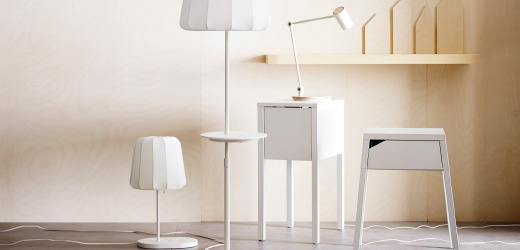Share This
Related Posts
Tags
Furniture with Charge
By Anca Gagiuc on Jul 21, 2016 in Technology
In today’s world, our homes, desks, cars, are filled with cables, adapters, outlets and battery packs designed for our ever increasing number of smartphones, wearable tech and, of course, the Internet of Things. Some have noticed the opportunity and began exploring a new industry that’s expected to boom in the next few years—the wireless charging indus

Wireless charging furniture from IKEA.
try or inductive charging. An innovative way this is playing out is wireless charging furniture.
Wireless Charging Collection from Ikea
Last spring, Ikea decided it’s time to untangle the web so it launched its line of wireless charging furniture; that was a moment when a future of effortless device-charging seemed reachable, even though all those lamps and side tables would still need to be plugged in or that some phones, including iPhones, need a special case in order to pair with the Qi wireless charging technology built into the furniture pieces.
“With the help of our wireless chargers, we make charging easy, fun and convenient, by turning furniture into charging spots. We enable convenient charging throughout the home, designed for your personal needs. At the same time, we make homes more beautiful by minimizing the use of cords. Nobody likes cords, yet everyone wants a fully functional home. With our wireless chargers, it’s possible to have both,” said Björn Block, IKEA range manager for lighting and wireless charging at the launch of their wireless charging collection.
The collection has items that range from $9.99 (the Romma cord management box) to $119 (the VARV floor lamp). It’s simple, minimalist and very Ikea; it consists of charging pads, desk lamps, bedside tables and a special pad that users can install in any piece of wood furniture they already own (and don’t mind doing the drilling themselves).
The charging pads are basically a cross in the middle of a circle that’s about two inches in diameter that use the Qi wireless standard. The majority of phone manufacturers support the Qi standard with the notable exception of Apple. Thus, for iPhones, Ikea came up with the Vitahult cases which include a Qi adaptor. It’s a bulky, unflattering case that feels as if it’s made of the same cheap plastic, but it gets the work done. On the other hand, the lamps and pads are actually quite good-looking.
Bottom line: if your phone support Qi wireless charging and you like Ikea’s collection, go for it. If you’re an iPhone owner, you might want to wait for a better option.
Curvilux Smart Furniture
Argentina-based Curvilux recently launched its first product on Indiegogo—the Curvilux nightstand. It’s a clean-lined piece of furniture that features not only the built-in wireless charging and USB ports, but also boasts integrated speakers, two programmable lighting systems, motion and temperature sensors, smart home integration capabilities and a drawer you can unlock with your phone. It comes with an app that enables users to program lighting to set up a simulated sunrise alarm clock. Moreover, it can charge up to three devices at once through the wireless and USB chargers incorporated.
The $50,000 crowdfunding campaign has been successful and met the funding goal which means that the nightstands will begin shipping in November 2016.
FurniQi from Fonesalesman
The London-based company specializes in standalone wireless charging pads, but it’s also developing FurniQi, a line of simple furniture pieces with built-in Qi wireless charging technology. The first in the range is a side table made of Mao Zhu Bamboo. The design is simple, with just a ring on the surface to indicate where the device should be placed to charge.
“Marking our entry into the world of furniture, we have put a lot of thought into the table’s design and usability,” Bavan Palasanthiran, founder of Fonesalesman, said in a press release. “The FurniQi side table is incredibly easy to assemble taking a mere 60 seconds from opening up the box to having a complete table ready to charge your device. This table brings wireless power naturally to your home, meaning charging your smartphone is now more convenient than ever.”
The prospect of this industry to grow into a mature one depends on the evolution of battery technology and William Stofega, program director of mobile device technology and trends at the International Data Corporation states that batteries in mobile devices are “five to 10 years behind the other components of the device.” Thoughts?
